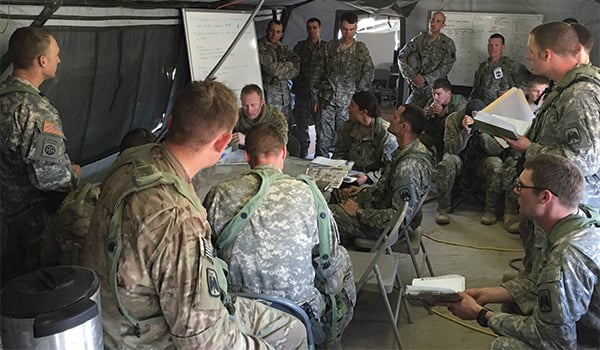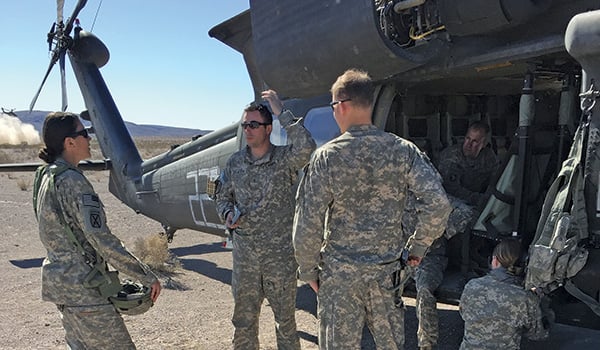
From the Field / By CPT James R. Antonides:Throughout my career, I have seen a distinct shift in the roles and responsibilities of who leads our missions and serves as air mission commanders. Have we replaced the value of doctrine and operational knowledge with tactical and technical experience? Have commanders abdicated responsibility for operational employment of their formations, and can they get it back? Should we revisit the roles we expect our platoon leaders, company commanders, and AMCs to fulfill in order to win the next fight?
LTC Kelsey A. Smith,
Senior Aviation Trainer,
National Training Center

Leadership from TF Tigershark, 1-229th Attack Reconnaissance Battalion (ARB), conducts Air Mission Briefing prior to deliberate attack during NTC Rotation 16-04. / ALL PHOTOS – U.S. ARMY PHOTO BY SPC ALTON PELAYO, 3-6 CAV
Over the course of the past 14 years of counter-insurgency (COIN) conflicts, the title air mission commander (AMC) has come to mean the following: the senior aviator in the flight who determines when and where to get fuel, how much station time is available, routes to use, and tactics for engaging targets. The determination to designate AMC generally takes place at the battalion leadership level and focuses primarily on the experience (flight hours), maturity, and judgment of the aviator to safely execute team level missions. In the decisive action (DA) environment, the shift of focus must be to leaders who can tactically and operationally employ formations of aircraft as part of a maneuver force. Our AMCs need to transition from fighting a team of two, to fighting platoons, companies, and whole battalion’s worth of aircraft. The commander must be able to determine when aviators possess tactical and doctrinal acumen to soundly employ formations to accomplish missions and also define the role of their platoon leaders in decisive action conflicts.
Defining Roles
Army Regulation 95-1 states, “When two or more aircraft are operating as one flight, the unit commander will designate one of the rated crewmembers of the flight as an AMC to be in command of all aircraft in the flight.” Oftentimes, this translates to pilots-in-command (PCs) who have demonstrated the ability to lead a team, have “enough” PC flight time as judged by the senior aviators of the battalion, and familiarity with the standard team missions being designated as AMCs. This means the AMCs ensure the team gets to the fight, executes their assigned tasks, and returns to base. AMCs often position themselves in the lead aircraft in order to best direct the aircraft in the team. This mindset has created the idea that the most senior aviator, in terms of hours, is often the AMC for the mission while also acting as PC of his aircraft. This places the responsibility for mission accomplishment on aviators who may not be prepared to make tactical decisions at the platoon or company level. AMCs that have operated exclusively in the COIN environment have not had the time or training to develop as AMCs in the more complex decisive action fight, which will create friction as the Army transitions to operations which combine both of the Army’s core competencies – combined arms maneuver and wide area security. As the Army transitions so must the focus of our commanders and AMC training programs.

Air crewmen from TF Warhawks, 2-158th Assault Helicopter Battalion (AHB), conduct a crew brief beside their aircraft prior to mission execution during NTC Rotation 16-03. / EAGLE TEAM NATIONAL TRAINING CENTER PHOTO
Tactical and Operational Decision Making
The transition from using aviation assets as the “911” force moved around the battlefield to the maneuver force most in need, to a maneuver force in and of itself, only serves to strengthen the argument that aviators who are designated AMCs must be proficient at tactical and operational decision making for platoon and larger elements. Likewise, according to the definition in AR 95-1, AMCs are to be chosen based on their ability to interpret and implement the commander’s intent. AMCs must be tactical experts at the small unit level. Many of the lessons learned for fighting as a team of two will translate into AMCs who can continue to perform duties with additional training and emphasis placed on doctrinal employment of aircraft. The role of the AMC in the DA environment will require them to make tactical and operational decisions over the course of the mission which will have far reaching consequences. The requirement to interpret and execute commander’s intent will require a sound doctrinal base of knowledge many of our junior warrant officer AMCs currently lack. Conversely, current senior warrant officer AMCs likely do possess this requisite operational knowledge, though they have not been challenged to exercise it – outside of a CTC rotation.
Developing Capability
Similarly, the role of platoon leaders on the battlefield needs to change to a more traditional decision-making position. Platoon leaders, although likely still working towards PC, are responsible at the lowest level for understanding the commander’s intent and implementing tactical decisions for fighting their platoons. This requires them to be in a position during the planning process where they can continually incorporate the commander’s guidance and refine their tactical plan to achieve the commander’s desired end-state. Every platoon leader, therefore, should be trained to fight their platoon as one cohesive fighting force, which is part of a larger company or battalion mission. The training of platoon leaders must not only include developing them as PCs capable of fighting one aircraft and AMCs employing teams, but also as leaders capable of maneuvering their platoons on the battlefield. Commanders must place their trust in these junior leaders and empower them to make decisions on their behalf. Similarly, senior warrant officers within the company will be expected to continue to grow this aspect of their abilities. AMCs will be required to make the same decisions they are making now, but will also have to make tactical decisions dictating the course of a fight. The commander must have AMCs that he or she trusts will execute the mission to achieve the desired end-state. To determine the best course of action in a given situation requires in depth understanding of both the mission and doctrine. By nature, AMCs must have a sound doctrinal foundation in order to tactically employ their formations and accomplish their missions. This implies a level of trust between the commander and designated AMCs to make decisions by junior leaders that affect an operation; decisions which, in the COIN fight, were traditionally made at the task force level. Decisions of this magnitude affect not only a team’s employment, but can also impact task force and brigade-level missions and have far-reaching consequences.
The decisive action fight for which we are preparing requires leaders at the lowest level to make decisions that will have operational effects. It is incumbent on commanders to select individuals that retain the qualities of a competent aviator and possess the requisite tactical knowledge to maneuver units to achieve success on the battlefield. Current AMCs must become doctrinally conversant and expand on the technical and tactical skills they already possess. As platoon leaders and junior warrant officers train to become AMCs, we must ensure we take advantage of live, constructive, and simulated training while ensuring the correct focus on operational employment. Through all of this, it is imperative that we continue to foster trust and empowerment throughout Army Aviation’s ranks so that our junior leaders are enabled to accomplish missions within their commander’s intent.
CPT James R. Antonides is the senior aviation battle staff analyst for the National Training Center at Fort Irwin, CA.










